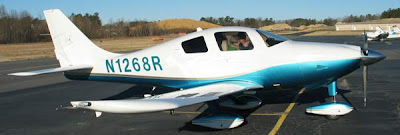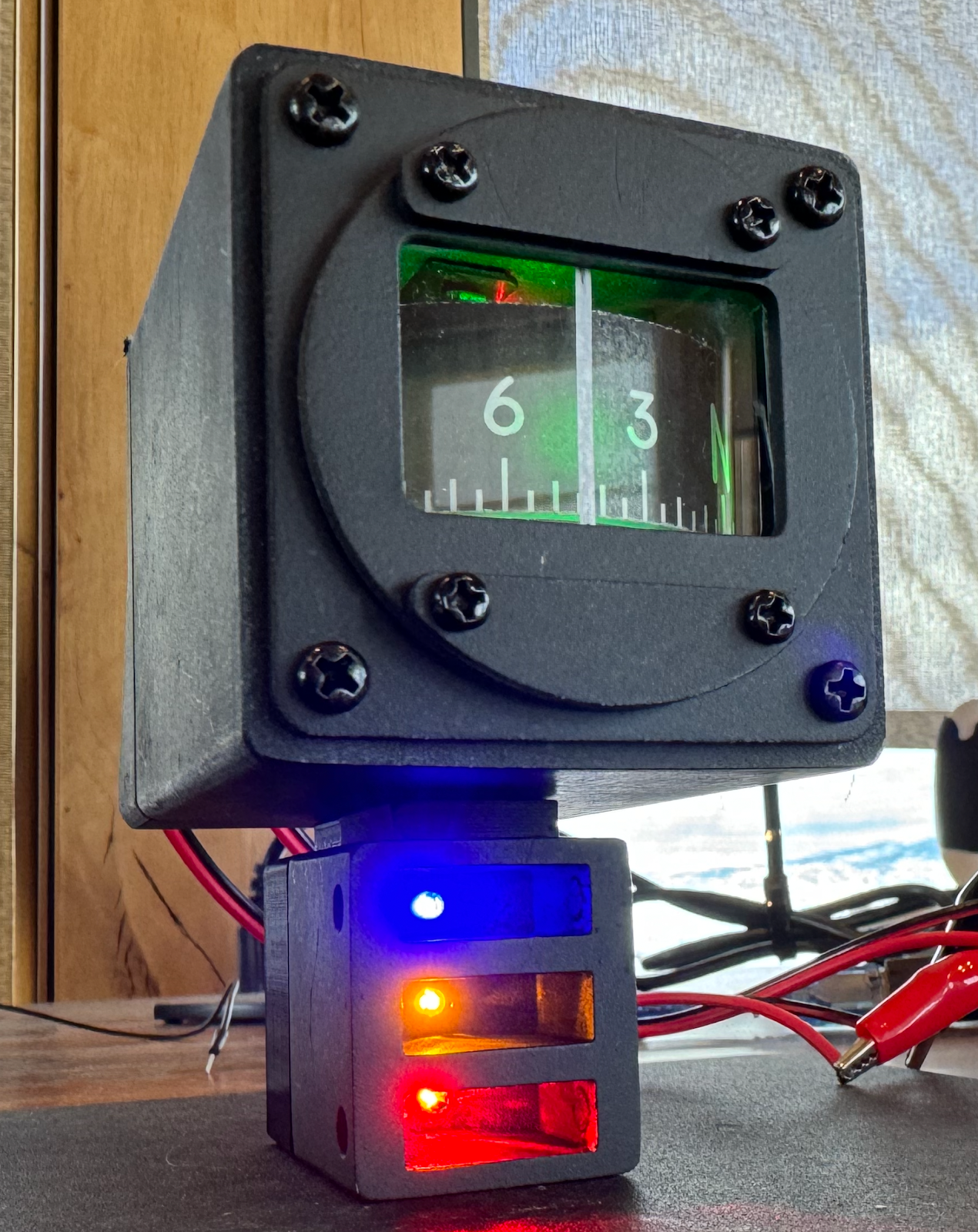Test Driving the Columbia 350
My wife and I are exploring the purchase of (a share in) a new airplane, at least one that's new to us. We're looking at airplanes from the Cirrus SR20 (which cruises around 155kts) all the way up to the Columbia 300/350 (which cruises around 185kts). We are generally steering away from retract airplanes, though nothing is set in stone.
Today a nearby Columbia Aircraft demo pilot flew into JGG to show off a Columbia 350 airplane with the Garmin G1000 glass cockpit. He spent nearly the entire day with us, showing off the plane to about 10 different people. I sat in the backseat for one trip, where I spent time filming, and then took the pilot's seat for an hour.
Let me start with the punchline:
The Col 350 is one hell of a machine. It would make an excellent cross country traveler.

Airframe and Engine
Even when fully loaded we saw climb rates around 750 ft/min (in cool air) and hit cruise speeds that trued out around 182 kts @ 6500 feet. The side stick control instantly felt natural - even more quickly than the Cirrus side yoke did.
Control responses were nice – they are transmitted through push rods instead of cable/pulley setups. This removes any “play” in the controls and gives excellent feedback when performing slow flight or stalls. At cruise speed the control forces needed to move the ailerons are fairly strong – I think I'd prefer the autopilot do most of the turning then.
The slow speed handling was even better than the cruise speed response. Straight-ahead, power-off stalls were benign and confidence-inspiring with the ailerons maintaining effectiveness all the way to the break.
Speed brakes are offered to help you drop knots without shock-cooling the engine with a large, quick power reduction. We played with them a few times and I found them to be very useful. They caused no ill effects to handling when used and brought the speeds down by 20 kts in 20-30 seconds. When the plane can cruise at 185 kts its helpful to get slowed down when you need to.
This video shows them in action:
The doors closed and opened easily and securely. There is a strap that you grab to pull the door down which wasn't perfect – it was a bit high to reach when closing the door and can get in the way when closing the door after shutdown.
The interior noise levels were excellent. Not only is the 310 horsepower engine smooth, but the airframe's sound insulation and vibration dampening really help keep the volume down. Throw a noise-canceling Bose headset in that mix and you have, by far, the quietest airplane I've even been near.
Here's a video of the startup sequence:
The visibility was a little lacking in the plane, especially forward visibility. It has a high dash and a relatively small forward windshield. I found myself leaning forward, trying to get a better view. Whenever I did, I'd hit the top of the headset on the ceiling.
There is no back window, which is not a big deal, but it would nice to be able to look back at the elevator/rudder when checking the flight controls.
The seating was very conformable. Not as much side-to-side room as the Cirrus, but plenty fine for even the longest trips. The backseat was comfortable too, though long trips would be best with just one person back there.
The overall fit and finish was top notch. I wondered if the plane would show some raw edges here and there, given its history starting as a kit plane, but there was none of that. It is obviously built by professionals with an attention to detail.
Avionics
I really like the G1000 – it seems more feature rich than what I've seen from the Avidyne setup. The integration is wonderful and the GFC 700 autopilot is rock solid. It has a FLC feature which stands for “flight level change”. The feature provides a constant airspeed climb/descent capability. This allows you to set the autopilot to maintain, say, 120 kts in a climb, all the way up to your chosen altitude. So as you climb, and the engine loses power in the thinner air, the nose will be automatically pitched down – no chance of getting near a stall attitude.

Other features of the G1000 include fairly standard, but quite valuable, glass panel functionality:
I spent about an hour at the controls ending with a landing on runway 31 at JGG. The landing wasn't my best, but its wasn't due to the airplane, I just didn't have a good feel for the rudder sensitivity yet. The approach was very stable, even in the bumpy air.

Today a nearby Columbia Aircraft demo pilot flew into JGG to show off a Columbia 350 airplane with the Garmin G1000 glass cockpit. He spent nearly the entire day with us, showing off the plane to about 10 different people. I sat in the backseat for one trip, where I spent time filming, and then took the pilot's seat for an hour.
Let me start with the punchline:
The Col 350 is one hell of a machine. It would make an excellent cross country traveler.

Airframe and Engine
Even when fully loaded we saw climb rates around 750 ft/min (in cool air) and hit cruise speeds that trued out around 182 kts @ 6500 feet. The side stick control instantly felt natural - even more quickly than the Cirrus side yoke did.
Control responses were nice – they are transmitted through push rods instead of cable/pulley setups. This removes any “play” in the controls and gives excellent feedback when performing slow flight or stalls. At cruise speed the control forces needed to move the ailerons are fairly strong – I think I'd prefer the autopilot do most of the turning then.
The slow speed handling was even better than the cruise speed response. Straight-ahead, power-off stalls were benign and confidence-inspiring with the ailerons maintaining effectiveness all the way to the break.
Speed brakes are offered to help you drop knots without shock-cooling the engine with a large, quick power reduction. We played with them a few times and I found them to be very useful. They caused no ill effects to handling when used and brought the speeds down by 20 kts in 20-30 seconds. When the plane can cruise at 185 kts its helpful to get slowed down when you need to.
This video shows them in action:
The doors closed and opened easily and securely. There is a strap that you grab to pull the door down which wasn't perfect – it was a bit high to reach when closing the door and can get in the way when closing the door after shutdown.
The interior noise levels were excellent. Not only is the 310 horsepower engine smooth, but the airframe's sound insulation and vibration dampening really help keep the volume down. Throw a noise-canceling Bose headset in that mix and you have, by far, the quietest airplane I've even been near.
Here's a video of the startup sequence:
The visibility was a little lacking in the plane, especially forward visibility. It has a high dash and a relatively small forward windshield. I found myself leaning forward, trying to get a better view. Whenever I did, I'd hit the top of the headset on the ceiling.
There is no back window, which is not a big deal, but it would nice to be able to look back at the elevator/rudder when checking the flight controls.
The seating was very conformable. Not as much side-to-side room as the Cirrus, but plenty fine for even the longest trips. The backseat was comfortable too, though long trips would be best with just one person back there.
The overall fit and finish was top notch. I wondered if the plane would show some raw edges here and there, given its history starting as a kit plane, but there was none of that. It is obviously built by professionals with an attention to detail.
Avionics
I really like the G1000 – it seems more feature rich than what I've seen from the Avidyne setup. The integration is wonderful and the GFC 700 autopilot is rock solid. It has a FLC feature which stands for “flight level change”. The feature provides a constant airspeed climb/descent capability. This allows you to set the autopilot to maintain, say, 120 kts in a climb, all the way up to your chosen altitude. So as you climb, and the engine loses power in the thinner air, the nose will be automatically pitched down – no chance of getting near a stall attitude.

Other features of the G1000 include fairly standard, but quite valuable, glass panel functionality:
- Moving maps galore
- Traffic alerts
- Satellite weather
- Winds-aloft data
- the list goes on...
I spent about an hour at the controls ending with a landing on runway 31 at JGG. The landing wasn't my best, but its wasn't due to the airplane, I just didn't have a good feel for the rudder sensitivity yet. The approach was very stable, even in the bumpy air.



Comments